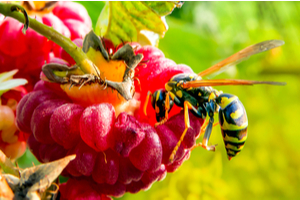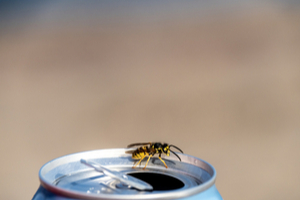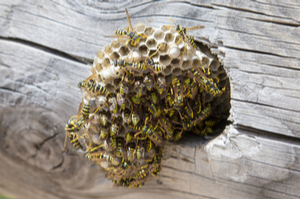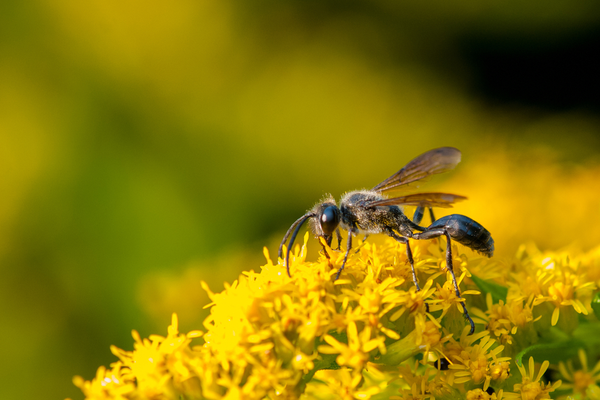Wasps, like bees, play different roles within their colony. Over time adult wasps have developed a strange reciprocal relationship with the larvae they care for. They each produce food for the other. As the nest goes dormant in fall, wasps become hungrier and more active in order to fend for themselves.
It’s not just you: wasps really are significantly more active in fall than they tend to be in spring or summer. And they can be more aggressive than usual! If you’ve ever wondered why it seems like you run into more wasps in the fall, we can explain. Here’s what you should know about what wasps eat and “the season of the wasp,” along with what you can do about it.
Why are wasps more aggressive in fall?
During the summer, wasps have a singular focus: feeding and protecting their colonies. Adults spend summer searching for food and bringing it back to the nest for larval wasps to eat. This insect-heavy summer diet consists primarily of:

- Ants
- Bees
- Beetles
- Aphids
- Spiders
- Fruit
- Honey
While adult wasps hunt and kill to bring food back to the hive, they themselves only eat sugars, like those found in fruit, sap and honey. Strangely, it’s only the larvae that are carnivorous.
Meanwhile, the larvae eat the hunted and chopped-up insects and produce a nectar for the adults. This fuels the hunters, so they’ll have the energy to continue finding food. As young wasps grow up, the queen continuously fertilizes eggs. This cycle ensures that there are always enough adult wasps, larvae–and nectar–to keep the colony going.
When summer becomes fall, the queen shuts down the nest and stops fertilizing eggs. No new larvae means no new nectar for adults. Instead, the last generation of larvae grow up and have to hunt for food on their own. To replace their beloved larval nectar, wasps seek out foods with more sugar than usual. They’ll fly further, stay out longer, and guard their spoils more aggressively. In other words, the wasps you run into this fall are hangry.
What do wasps eat in fall?

Larval wasp nectar is rich in sugar and carbohydrates. In fall, wasps need to find a way to replace those sugars and carbohydrates by altering their diets. To accomplish this, wasp diets become quite varied. They’ll consume fruit, honey, nectar and small insects but also:
- Garbage
- Sugary snacks
- Soda
- Meat
You’ll probably see a lot of wasps crashing your picnic or gathering around your garbage dumpster this fall. Human food and garbage is often a great source of sugar and carbohydrates.
Different types of wasp species have different food preferences. Paper wasps ingest wood and wood pulp to build their nests. Mud dauber wasps have been known to target and hunt spiders. Yellowjackets will eat the same types of meat humans do if they can get their hands on it. Whatever the particular wasps near you want, just keep in mind that they’ll want more of it this fall.
Are wasps dangerous during fall?
The main damage a wasp inflict is psychological. Human beings see their nests and immediately panic. Wasp stings hurt, and when they swarm, wasps can inflict a significant or even dangerous amount of pain. Unlike bees, wasps can sting repeatedly and are more inclined to attack you in fall than they are during the summer.
If you run into a wasp between September and November, try to keep your distance. Move away from the wasp slowly and steadily. Don’t make sudden movements, lunge or throw something at the wasp, or otherwise react aggressively.
If you are stung by a wasp, keep the wound clean and use a cold compress for relief. You can check Healthline for more information about what to do for a wasp sting.
How to get rid of wasps in the fall
There are a number of ways to keep wasps out of your home or business during the fall. Start by:

- Watch for nests. Wasps usually build their nests in lofty, inaccessible, covered areas. Around homes, they’re common on roof eaves, rafters, lofts, or in garages or sheds. By fall, wasp’s nests will be large and established. Most wasp’s nests are built of regurgitated wood pulp and look like paper or wood. If you see a wasp’s nest, do not attempt to remove it yourself. Not only is this dangerous, but it will also likely be ineffective. Instead, call in the pros. Removing a wasp’s nest from your property is the best way to reduce wasp presence near you.
- Limit their access to your food. Wasps are all about food in fall. If they can’t get food near you, they’ll have to find it elsewhere. Secure your trash cans, clean up outdoor spills, and avoid eating meals outdoors during fall. The harder you make it for wasps to eat near you, the fewer wasps you’ll have to deal with.
- Clean up yard debris regularly. This is a good tip for all deterring all pests, not just wasps. Pests use yard debris as a way to hide as they approach your home. If you clean up yard debris like leaves regularly, you’ll make your yard far less appealing to potential pests. Proper lawn care in fall makes a big difference when it comes to pest prevention.
What do wasps do in winter?
By November you should be seeing the last signs of any wasps in your neighborhood. For better or worse, the reality is: most wasps don’t survive the winter.
After their heroic push to locate new foods and survive the fall, most wasps die off. The only members of the colony to survive are the females who will go on to breed and become queens in the following year. These few royals will hibernate over winter and remerge in the spring to start their dynasty in a new nest.
How to get rid of a wasp nest
Wasps can be scary, especially during fall. If you suspect you have a wasp problem or see a nest, call the team at Griffin Pest immediately. We’ll send a certified pest technician out to assess the situation and apply an integrated pest management plan. Enjoy all seasons without the fear of upsetting hungry wasps.

